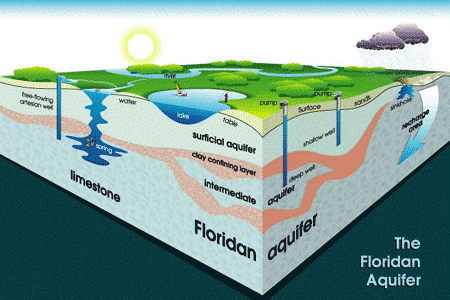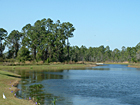Know Your Watershed
Your watershed is the land area that catches and contributes water to a water body. Water resources within a watershed are affected by what happens on the land within that watershed.
Harmony is located within the upper reaches of the Kissimmee River watershed. Much of Harmony drains either to Buck or Cat Lakes. Buck Lake drains across US 192 to Alligator Lake while Cat Lake discharges to the north, taking a more circuitous route through Lake Conlin and Lake Lizzie before also emptying to Alligator Lake. From there, the water makes its way to the Kissimmee River and ultimately to the Florida Everglades. Find out about Harmony's watershed.
See the flow of water to the Everglades
Anything on the land can eventually impact the water resources. In Florida, surface water and ground water are connected through a variety of ways because of the karst landscape.
What is a karst landscape?
Derived from the Slovenian kars, meaning rock, karst landscapes are underlain by limestone that is easily dissolved by carbonic acid (water and CO2).

Floridan Aquifer, "Florida's rain barrel"
Aquifers are underground rock and cave systems that hold water.The Floridan Aquifer is one of the most productive aquifers in the world and our main source of drinking water. It reaches across southern Alabama, southeastern Georgia, southern South Carolina and all of Florida and is covered in varying thicknesses of sand, clay, and limestone.
Water in the aquifer is replaced by rainfall that soaks into the ground, a process known as recharge, but this does not occur everywhere. Areas of high recharge include the well-drained sand ridges of central and west-central Florida.
Maintaining natural areas is critical for maintaining water supplies. The sand surface of central Florida is porous, making it easy for water to flow through it and recharge the aquifer. Water cannot soak through the pavement that comes with intense development.
Sinkholes, "An aquifer phenomenon" Sinkholes are depressions in the surface land when the rainwater dissolves the underlying limestone or when the roof of an underlying cavern collapses. Sinkholes connect the surface water to groundwater. How sinkholes form (PDF) Types of sinkholes (PDF) Map of Florida geology and sinkhole formation (PDF) While sinkholes are common in portions of Florida, Harmony is located in an area where they are not likely to develop. Encouraging water to remain on the property and soak into the ground through Harmony's many wetlands and stormwater retention ponds also helps to keep the water table at its natural levels and prevent sinkhole formation.
 Lakes
Lakes
Florida has thousands of lakes, large and small. Most of them were formed in same manner as sinkholes. Ground water dissolved the underlying limestone, forming underwater cavities. When the roof of the cavities collapsed and formed a depression, they were filled with groundwater and rainwater. In addition to natural lakes, Florida has many human-made lakes used for irrigation, mining, and aquaculture. Some lakes and ponds are designed to manage stormwater runoff from developed areas.
For more information, see Florida Lakes and Ponds
 Rivers
Rivers
The most common type of river in the karst region of north-central Florida are spring-fed rivers, where the limestone is close to the surface.
Wetlands
These are areas of land periodically covered by water and have many names, including swamps, marshes, and bogs to name a few. There is particular concern for the preservation of these areas because they perform many valuable functions for the state's ecosystem. Wetlands provided habitat for fish and wildlife, improve water quality by trapping nitrogen, phosphorous, and other substances, intercept and slow down run-off, and protect shorelines from erosion and upland areas from floods.
How is it all connected?
The connection between groundwater and surface water means that anything found in the surface water can find its way into the groundwater.
Water pollution occurs when a body of water is contaminated with the addition of materials and chemicals not intended for use. Because water plays a major role in Florida's diverse habitats and wildlife populations, pollution impacts the environment, human health, and the availability of clean water resources.
For more information on preventing water pollution, read our water quality page.

